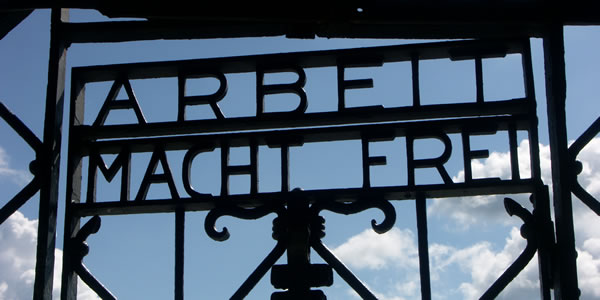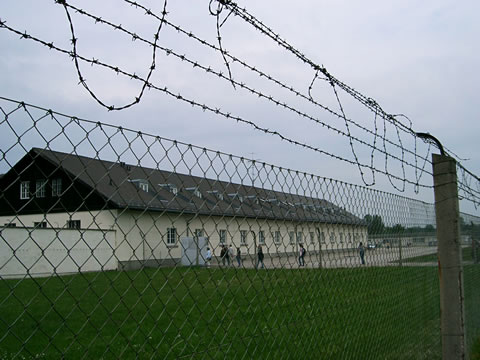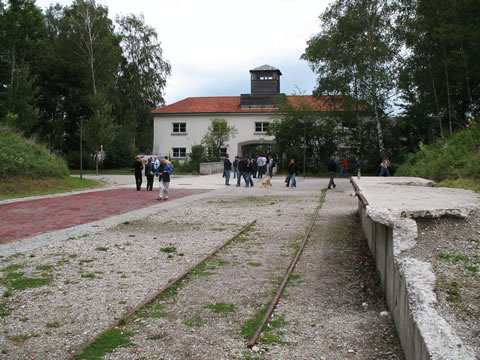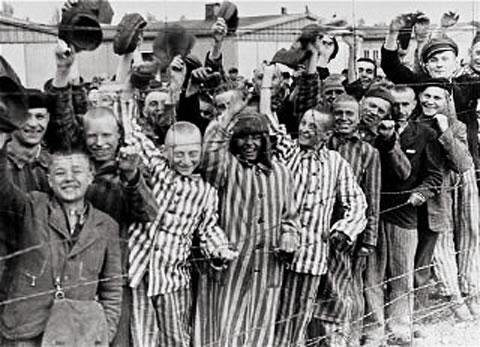Dachau ★

The cruel sign on the gates at Dachau, promising (falsely, of course) that work would bring freedom.
The Dachau Concentration Camp Memorial Site, a Nazi concentration camp outside Munich

The fence at Dachau. (Photo by Edwin Lee) On March 22, 1933—just a few weeks after Hitler rose to power as Reich Chancellor—SS leader Heinrich Himmler set up Nazi Germany's first concentration camp in a little town outside Munich called Dachau.
Between 1933 and 1945, 206,000 prisoners were officially registered here, and countless thousands more were interned without record.
By the gate as you enter is inscribed the taunting Nazi slogan Arbeit Macht Frei ("Work Makes Freedom")—as if working hard and being a model prisoner made any kind of difference to ones fate.
Each of the barracks at the camp was built to house 208 people; by 1936, they accommodated up to 1,600 each.

A building at Dachau with the remains of the rail depot that once delivered prisoners in the foreground. (Photo by Andrew Bossi)While Allied troops razed the 32 prisoners' barracks to the ground when they liberated the camp on April 29, 1945, two of them have been reconstructed to illustrate the squalid living conditions.
The former kitchen is now a museum whose photographs document the rise of the Nazis and the persecution of Jews, communists, gypsies, homosexuals, and other "undesirables."
There's also a short documentary film (the English version usually shows at 11:30am and 3:30pm).
At the back of the camp are the ovens of the crematorium and a gas chamber disguised as showers.
No prisoners were actually gassed at Dachau (however, over 3,000 Dachau inmates were sent to an Austrian camp to be executed in this manner). This room was simply used for beatings and pointless, cruel interrogations.

The liberation of Dachau, 29 April 1945.Although Dachau—unlike other camps such as Auschwitz in Poland—was primarily for political prisoners and not expressly a death camp, more than 41,500 people died here from the brutal conditions, and thousands more were outright executed.
The camp is scattered with Jewish, Catholic, and Protestant memorials.
How to get to Dachau
To spend an hour or two here remembering the darkest days of modern history, either take a tour or hop the S2 S-Bahn train from Marienplatz to Dachau (direction: Petershausen) in 25 minutes.
(Note that this is six zones out from the center; if you have a inner city day pass for the S-Bahn, it won't cover it; you need the "XXL Munich" pass for this day.)
From Dachau station, bus 726 (direction: Saubachsiedlung) takes you to the camp.
Tips & Links
Alte Römerstraße 75, Dachau
Tel. +49-(0)89/669-970
www.kz-gedenkstaette-dachau.de
OPEN
Daily 9am–5pm (administrative office & archives closed Mon)
ADMISSION
Free
TRANSPORT
S-Bahn: Dachau (S2), then bus 726.
TOURS
• Private Tour: Dachau Concentration Camp Tour from Munich
• Dachau Concentration Camp Memorial Small Group Tour from Munich
• Dachau Concentration Camp Memorial Afternoon Tour from Munich
• Also possibly of interest: Hitler and the Third Reich Munich Walking Tour

Planning your time: Budget at least half a day for Dachau, including transportation.
Though admission is free, in-depth guided tours—at 11am and 1pm and lasting 2.5 hours—cost €3.
Or you can visit Dachau on a guided tour from Munich via our partners Viator.com:
Tourist info: Muenchen.de, Bavaria.by, Germany.travel
Tours & activities: Viator.com, City-Discovery.com, Intrepidtravel.com, Gadventures.com
LODGING
- Apartments & villas:
- Vrbo.com
- Booking.com
- Venere.com
- Rentalo.com
- Homeaway.com
- Belvilla.com
- Interhomeusa.com
- Airbnb.com
- Villasintl.com
- Craigslist.org
TRANSPORT
- Airfares:
- Momondo.com
- AutoEurope.com
- Vayama.com
- CheapOair.com
- Cheapflights.com
- DoHop.com
- CheapTickets.com
- Priceline.com
- Trains:
- Bahn.de
- Raileurope.com
- Seat61.com
- Car/RV rentals:
- Autoeurope.com
- Momondo.com
- RentalCars.com
- CheapOair.com
- AutoSlash.com
Bike rentals & tours: Viator.com, Mikesbiketours.com
- Sightseeing
- Food & beer
- Day-trips
- Excursions
- Munich City Hop-on Hop-off Tour
- Munich Bike Tour
- Munich Segway Tour
- Private Tour: Munich Segway Tour Including Chinese Tower Beer Garden
- Private Tour: Munich Electric Bike Tour
- Munich Art Tour: Neue Pinakothek
- Hitler and the Third Reich Walking Tour
- Private Tour: Munich Sightseeing Including Andechs Monastery
- Munich City Tour including FC Bayern Soccer Grounds Visit
- Munich Ghost Walking Tour
- Munich Super Saver: Paulaner Brewery and Beer Tour plus Express Hop-On Hop-Off Tour
- Munich Oktoberfest Tickets and Tour
- Munich Christmas Markets Tour
- Munich City and Bavaria Film Studio Tour
- Hard Rock Cafe Munich
- Munich by Night and Dinner at Hofbrauhaus
- Munich Oktoberfest Tickets and Tour
- Bavarian Beer and Food Evening Tour in Munich
- Munich Bavarian Food Walking Tour
- Behind-the-Scenes Paulaner Brewery and Beer Tour in Munich
- Munich Super Saver: Paulaner Brewery and Beer Tour plus Express Hop-On Hop-Off Tour
- Munich Segway Tour During Oktoberfest
- Private Tour: Royal Castles of Neuschwanstein and Hohenschwangau from Munich
- Private Tour: Dachau Concentration Camp Tour from Munich
- Royal Castles of Neuschwanstein and Linderhof Day Tour from Munich
- Salzburg Small Group Day Tour from Munich
- Salzburg and Lake District Day Tour from Munich
- Neuschwanstein Castle Small Group Day Tour from Munich
- Dachau Concentration Camp Memorial Small Group Tour from Munich
- Dachau Concentration Camp Memorial Afternoon Tour from Munich
- Romantic Road, Rothenburg and Harburg Day Tour from Munich
- Berchtesgaden and Eagle's Nest Day Tour from Munich
- Nuremberg Day Trip from Munich
- Private Tour: Nuremberg Day Trip with Train Transport from Munich
- Nuremberg Third Reich and Roman Empire Historical Day Trip
- Herrenchiemsee Palace Rail Trip from Munich
- Royal Castle of Herrenchiemsee and Fraueninsel Day Tour from Munich
- Ettal Monastery and Zugspitze Day Tour from Munich
- Swarovski Crystal Worlds and Innsbruck Day Trip from Munich
- Royal Castle of Linderhof and Oberammergau Day Tour from Munich
- 3-Day Munich to Frankfurt Tour - Romantic Road, Rothenburg, Hohenschwangau, Neuschwanstein
- 4-Day Tour from Munich to Frankfurt: Romantic Road, Rothenburg, Augsburg, Neuschwanstein Castle
- 2-Day Munich Super Saver: Salzburg and Lake District Day Trip plus Romantic Road and Rothenburg Day Trip
- 2-Day Royal Castles Tour - Linderhof, Hohenschwangau, Neuschwanstein
- 2-Day Munich to Frankfurt - Romantic Road, Rothenburg
- 5-Day Tour from Munich to Frankfurt: Rothenburg, Augsburg, Zugspitze
- 4-Day Munich to Frankfurt - Romantic Road, Linderhof, Hohenschwangau, Neuschwanstein
- 3-Day Munich to Frankfurt - Romantic Road, Heidelberg, Rothenburg

Related Articles |
|
This article was by Reid Bramblett and last updated in September 2013.
All information was accurate at the time.
Copyright © 1998–2013 by Reid Bramblett. Author: Reid Bramblett.
Alte Römerstraße 75, Dachau
Tel. +49-(0)89/669-970
www.kz-gedenkstaette-dachau.de
OPEN
Daily 9am–5pm (administrative office & archives closed Mon)
ADMISSION
Free
TRANSPORT
S-Bahn: Dachau (S2), then bus 726.
TOURS
• Private Tour: Dachau Concentration Camp Tour from Munich
• Dachau Concentration Camp Memorial Small Group Tour from Munich
• Dachau Concentration Camp Memorial Afternoon Tour from Munich
• Also possibly of interest: Hitler and the Third Reich Munich Walking Tour

